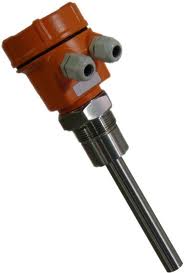Difference between revisions of "Vibrating Rod Level Sensors"
| Line 1: | Line 1: | ||
[[Category:Detectors, Sensors]]{{Knoppen}} | [[Category:Detectors, Sensors]]{{Knoppen}} | ||
[[File:Vibrating Rod Level Sensors.jpg|thumb|right|Vibrating Rod Level Sensors]] | |||
'''Vibrating Rod Level Sensors''' is a piezoelectric driven vibration type level switch that detects high, mid and low level in [[Bins]], [[Silos]], and [[Hoppers]] filled with powders or dry bulk solid materials. | |||
==Principle of operation== | |||
The vibrating rod level sensors are piezoelectric devices with a single rod shaped vibrating element. The rod of the sensor vibrates if there is no material covering the active rod. When the rod is covered with material, the vibration is dampened and an electronic circuit forces a relay to switch. When the rod gets uncovered, the vibration will restart and the relay will switch back. The rod is fixed at two points in a way that it forms a perfect swinging- system with very low mechanical losses . If you hit the end of the rod, it will vibrate on its resonance frequency and ring like a tuning fork. In action, the vibration is driven by a piezo system, which gets electrical pulses from the electronics. These electric pulses enlarge the size of the piezos which leads to a bowing of the rod. Since the pulses are exactly on the frequency where the rod is in resonance, the whole rod starts swinging. A second piezo system works as a swinging detector. If the piezo gets distorted, it gives a voltage signal to the electronics. This way, the electronics can check if the rod is vibrating or not. | |||
Latest revision as of 22:44, 10 February 2013
Vibrating Rod Level Sensors is a piezoelectric driven vibration type level switch that detects high, mid and low level in Bins, Silos, and Hoppers filled with powders or dry bulk solid materials.
Principle of operation
The vibrating rod level sensors are piezoelectric devices with a single rod shaped vibrating element. The rod of the sensor vibrates if there is no material covering the active rod. When the rod is covered with material, the vibration is dampened and an electronic circuit forces a relay to switch. When the rod gets uncovered, the vibration will restart and the relay will switch back. The rod is fixed at two points in a way that it forms a perfect swinging- system with very low mechanical losses . If you hit the end of the rod, it will vibrate on its resonance frequency and ring like a tuning fork. In action, the vibration is driven by a piezo system, which gets electrical pulses from the electronics. These electric pulses enlarge the size of the piezos which leads to a bowing of the rod. Since the pulses are exactly on the frequency where the rod is in resonance, the whole rod starts swinging. A second piezo system works as a swinging detector. If the piezo gets distorted, it gives a voltage signal to the electronics. This way, the electronics can check if the rod is vibrating or not.
